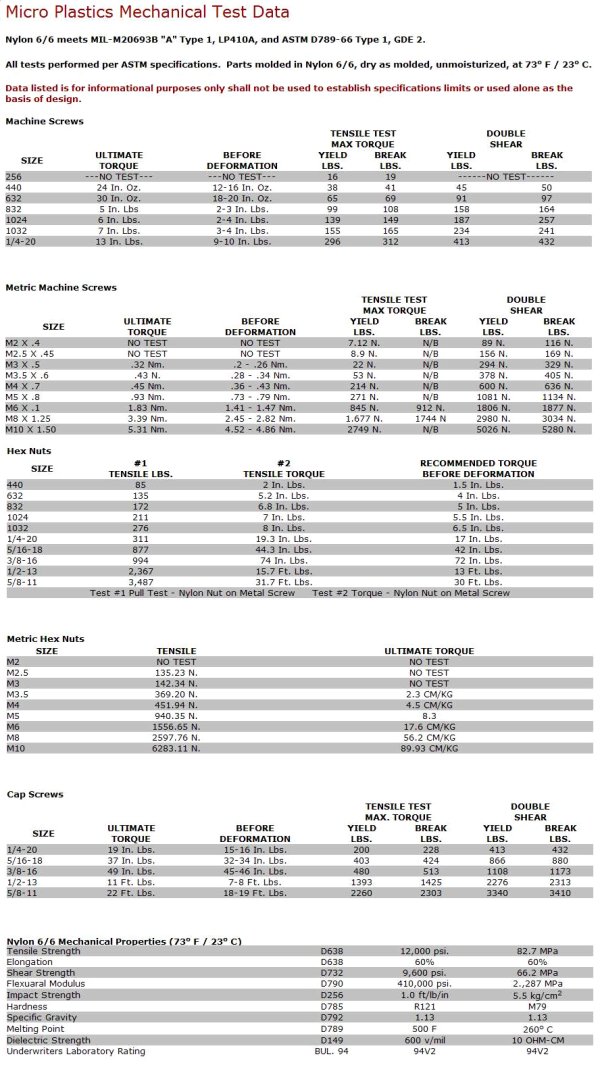Shear pin question: can anyone provide the raw math on the relative strength of using 4 ea. #4 screws vs. 3 ea. #6 nylon screws? I'm nearing the moment when I drill for shear pins on my 75mm M rocket. I'm divided on whether to go with 4 small screws or 3 big ones.
The rocket is 75mm. As I'm hoping to get it way, way, way up there, I do not want to even think about apogee deploy. As always, I will have holes for any excess air to bleed away from the respective chambers - especially critical on high velocity flights.
Any data that anyone can share would be appreciated- JW
I'm using 4 x 4-40 nylon screws for shear pins on my 5" L3 bird. Don't know if that means anything, but number 6 screws are at least twice as shear resistent than 4-40.
W
From Rocket Materials 4 x #4 screws has an average of 152 lbs before they sheared. I'm looking up nylon in one of my books and will have some math later.
Edward
That sounds just about right to me Edward. I think I was seeing 48# shear per screw if torqued to the point they very slightly stretch. 42# if loose.
W
Here's a link with formulae:
http://www.roymech.co.uk/Useful_Tables/Screws/Thread_Calcs.html
http://www.rocketmaterials.org has the tested (single) shear strength of nylon screws at:
#2-56 @21.36-24.64#/screw
#4-40 @38.21-40.30#/screw
#6-32 @60.46#/screw
From recent experience: If you want to use nylon screws as shear pins DO NOT, IN ANY WAY, tighten the screws down, which creates a clamping force between the airframe and coupler. This additional normal force (pressure x coefficient of friction) may keep your rocket from separating if you tuned your charges to shear forces alone. It could as much double your BP charge requirements.
For example a 4-40 (nylon or steel) screw torqued to 2 inch pounds (that's the max before breaking) will exert 41# of axial clamp force. This is the force you would have to exert to separate the two surfaces without the shear component. Add in the shear force of 40+ pounds, you are now looking at 80# to overcome by pressure. So unless you have a calibrated torque screwdriver, you will never know how much force you have to overcome. Using shear alone is the only consistant metric you can use, which is why the styrene rod concept is a good one., or use a threaded airframe and a coaxial clearance hole in the coupler, to prevent any clamping forces. Reference:
http://www.engineersedge.com/calculators/torque_calc.htm
However if you don't want to go through the numbers here's the Mechanical Test Data from a Nylon screw manufacturer. I would use the single shear numbers (which is less than double shear) in our application above from the test data at rocketmaterials.org. What you shear this with (the two opposing materials) can affect the outcome. If they are spongy, the data is skewed. As long as there is a slip fit, and hard materials, the screw data is perfect.
Thanks to all who responded on and off line. I think I will go w/ 4 ea. #4 screws. I procured some heavy polystyrene rod, but got to worrying about how things may shrink at 40,000' MSL (it is c-c-cold up there!) and decided to stick with something that was threaded.
Ground tests this weekend!
JW
One way to avoid the clamping force is to only thread one of the tubes. Preferably the one that holds the head of the nylon bolt after shearing so that it can be removed.
For the non-threaded hole just drill it out slightly larger as if you just stripped the threads.
Just my 4-40's worth...
I don't believe in Taping the holes at all. I use nylon screws and drill them as such so they push in but very tightly. In some cases you need to use something to push them in with.. say a quarter or even the head on some plyers. This also eliminates the issues with additional friction caused by screwing them in to tight.
I typically thread the outside but not the inside. Meaning that I thread the airframe, but not the nosecone or the e-bay. This holds the screws in, but provides no clamping force. The screws stay in, but no additional friction is generated.
Warren




